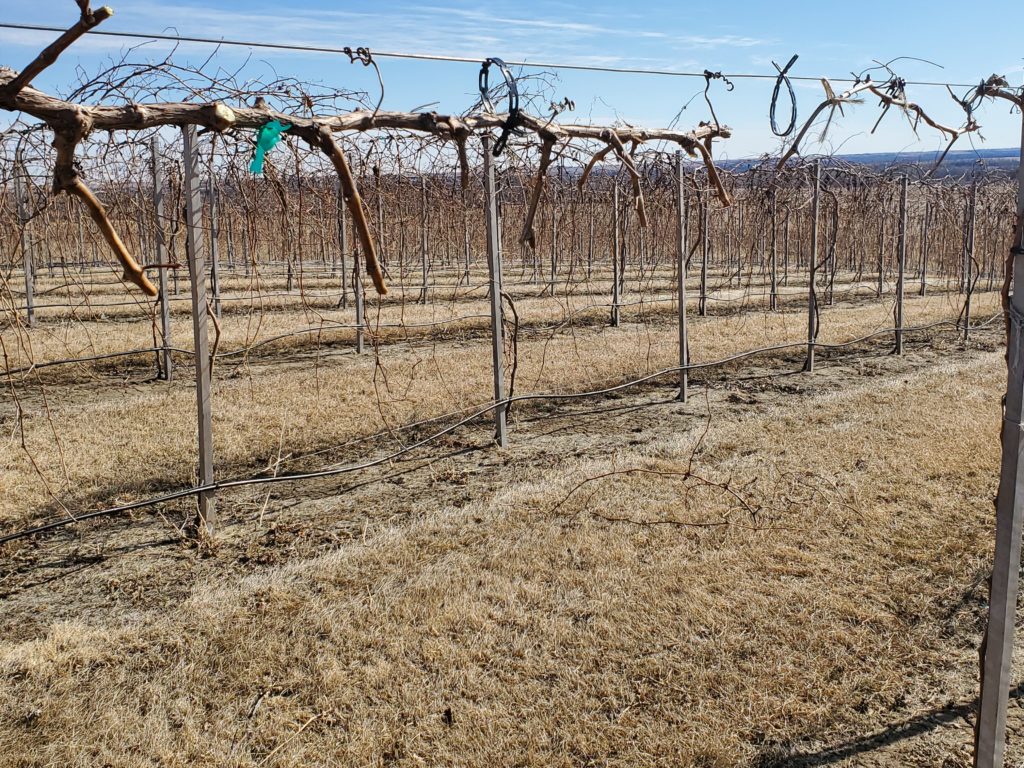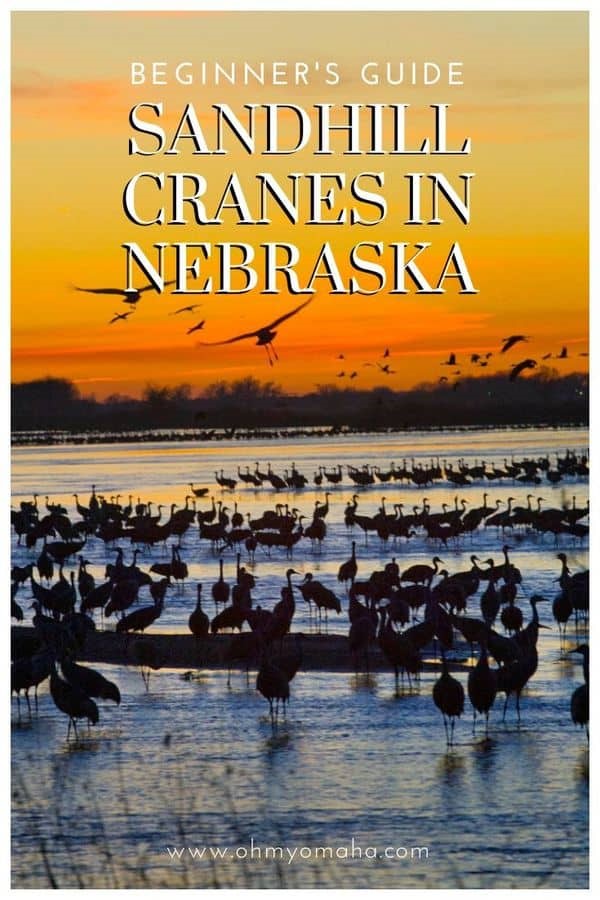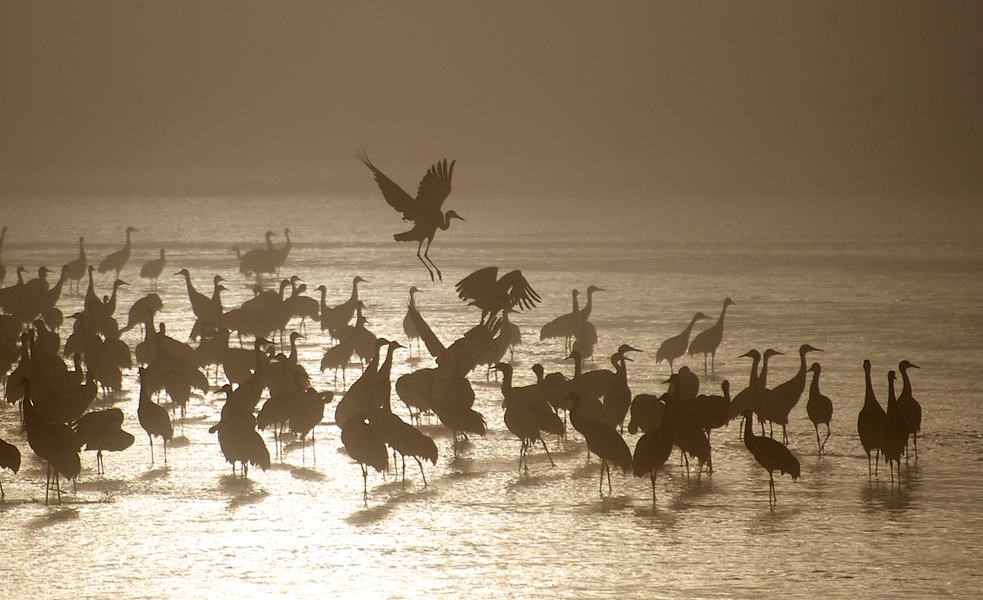By Mick McDowell, a Nebraska a winemaker
A brief numbers focus today Week 4 – Sandhill Crane Counts 2020 – as reported by Andrew Caven, Director of Conservation Research. “Sandhill Cranes leaped into Nebraska this the leap day” as we counted a bias adjusted 196,400+/- 47,570 Sandhill Cranes, well up from last week’s count of 34,500+/-1,200. Warm conditions on major Sandhill Crane wintering grounds and winds out of the south in the central and southern Great Plains likely aided this mass arrival.
This count was taken before last weeks 70° temps, so I’m sure the numbers are up significantly again.
*******
This Nebraska wine blogger is definitely enjoying the nice weather for pruning. Pruning the Itasca’s south of the tasting room and they are all high wire trained. Holding my hands above my shoulders with pruning sheer in tow, my shoulders feeling the burn with this above my head posture for two hours at a time. I’m getting used to it though and our spectacular hilltop view of the prairie and river valley help pass the time. Yes, we still have prairie as 40% of our county remains untouched native grasslands.

I’m also getting antsy to make the 30 minute trip into the Platte valley for my first look that the 2020 Sandhills Crane migration. Perhaps I’ll take a bottle of Gold Medal Edelweiss or a Brianna wine, some cheese, crackers and Charcuterie, (shaar-koo-tr-ee) board, to enjoy somewhere along the way.
You can stop up to the winery after you’ve traveled the day watching cranes for a nice bottle of wine and perhaps dinner prepared by our chef. We’d love having you at Miletta Vista, and if you’ve never been to central Nebraska to drive the area around the Platte River looking for cranes, or even sat in a bird blind, (sunrise or sunset) here is a simple guide and etiquette blog to to help you understand some of the simple do’s and don’ts of crane watching!
Beginner’s Guide To Sandhill Cranes In Nebraska (2020)
March 3, 2020 by Kim
One of Nebraska’s most epic experiences is getting the chance to observe the sandhill crane migration in Central Nebraska. Bird-watchers from around the world flock to the state each spring to witness the marvel. But what about the rest of us? If you’re not a well-versed birder, here’s how to get the most out of seeing the sandhill crane migration.

What’s so special about sandhill cranes?
Everyone says you’ve got to see the sandhill crane migration at least once. Why?
I think I read the best explanation in Smithsonian.com: “Every year 400,000 to 600,000 sandhill cranes — 80 percent of all the cranes on the planet — congregate along an 80-mile stretch of the central Platte River in Nebraska, to fatten up on waste grain in the empty cornfields in preparation for the journey to their Arctic and subarctic nesting grounds. This staging is one of the world’s great wildlife spectacles, on a par with the epic migrations of the wildebeest and the caribou.”
Why is Nebraska so important to sandhill cranes?
There’s a stretch of the Platte River in Nebraska that serves as a rest stop for hundreds of thousands of migrating cranes twice a year.
And just a heads up so you look like you know what you’re doing, there are more than just sandhill cranes to view while you’re there. There have been at least 257 species of birds observed in the Rainwater Basin including 27 species of waterfowl, 27 species of shorebirds, and five threatened and endangered species (whooping cranes, bald eagles, least terns, piping plovers, and peregrine falcons).
Where are the best places in Nebraska to see the sandhill cranes?
There are several communities in central Nebraska that are prime starting points for sandhill crane viewing. Kearney, Neb., is known as the Sandhill Crane Capital of the World…for good reason. By all accounts, the most cranes seem to arrive in that area (like 400,000 to 600,000).
Of course, places like Grand Island or North Platte are not to be overlooked. You’ll still see hundreds of thousands of cranes there in March, too.
Related post: Headed for Kearney, Nebraska? You’re going to need some restaurant suggestions! Start with these seven must-try places to eat in Kearney.
When is the sandhill cranes’ migration in Nebraska in 2020?
The cranes usually start arriving in mid-February continue in waves until in mid-April. The peak is typically the last week of March.
Audubon Nebraska’s 50th Crane Festival commemorating the migration is March 20 and 21, 2020 in Kearney. This would be a great festival to not only to view the cranes, but to learn everything from the basics about the cranes to in-depth presentations on habitats and conservation. Registration is open and includes Saturday meals and a T-shirt: $160, adult; $70, student (high school and above); and $30, child.
Are there sandhill crane viewing tours?
Of course, there are bird-watching tours! There are some that you’ll have to get up at the crack of dawn to take advantage of (as well as overnight options). And then there are the options for a guided experience for the average person who isn’t a major birder.

Photo courtesy Nebraska Tourism Commission
For the serious birder
It’s recommended that you reserve a blind if you want to get up close to the migrating cranes. In Kearney, Neb., your best bet is Rowe Sanctuary. You’ll spend between $20-$40 to rent one for a few hours.
Serious bird photographers are going to want to consider guided tours that include photography blinds ($100) and overnight blinds ($250).
For the casual birder
Don’t want to early morning? If you’re in the North Platte area, you can do a tour with Dusty Trails LLC, which starts its tour at 2:15 p.m. (and ends at about 5 p.m.). In 2020, the tours will be held on Saturdays and Sundays, March 14 and 15, and then daily from March 20 through April 8.
Dusty Trails’ Tours are $35 for adults, $17/50 for children ages 5-10, and FREE for children ages 4 and younger.

Photo courtesy Nebraska Tourism Commission
What if I told you that you could go bird-watching without going outside? (I’ve done this in eastern Nebraska, actually). Iain Nicolson Audubon Visitor Center at the Rowe Sanctuary has that option every Wednesday evening starting at 6 p.m. during the migration season. This is a great option for families since they have kid’s activities while you waited for the birds to arrive.
The cost for evening at the Audubon Visitor Center is $10 per person and kids 4 and younger are admitted for FREE. The 2020 dates are: March 11, 18, 25, and April 1 and 8. The Rowe Sanctuary is located about 20 miles from Kearney at 44450 Elm Island Road in Gibbon.
Where are crane viewing sites?
I remember my parents taking us kids on a wild ride one year, trying to find the birds and it was just the most unimpressive experience. I remember standing in a field, shivering, just to see about a dozen birds and wondering what the big deal was. Clearly, my parents hadn’t researched where we needed to go…or we were lost and not at a legit viewing site.

Photo courtesy Nebraska Tourism Commission
Save yourself the bad memories and go to one of these sites instead:
– One of your best bets to not only learn about cranes, but see them, is to head to the Crane Trust Nature & Visitors Center (located at 9325 S. Alda Road in Wood River, Neb.). Here, you can see the displays and then head outdoors to the 35-foot observation tower and the 10 miles of nature trails along the Platte River. Some trails may be closed to protect cranes that are roosting or loafing.
– For sunrise and sunset viewing near Kearney, go to Fort Kearny Bridge spanning the Platte River. You’ll need a state park permit to get into the Fort Kearny State Recreation Area. The address is 1020 V Road, Kearney, Neb.
– A free option is located just off the Interstate 80 exit to Gibbon. To get to the Plautz Viewing Platform, take Exit 285 and drive 1 ½ miles south. The Central Platte Natural Resource Department has view decks set up for a good view of the sandhill cranes, as well as herons, egrets, and pelicans. Parking is free.
– CPNRD also has a view site set up near Alda, Neb. Take the Interstate 80 Exit 305 to Alda and drive 2 miles south. Find three roadside turnouts south and east of the Alda interchange on Platte River Drive, and west of Rowe Sanctuary on Elm Island Road.
Is there bird watching etiquette?
Good question. Since we’re all non-birders here, I’m guessing this is on everyone’s mind. Of course there’s etiquette.

Photo courtesy Nebraska Tourism Commission
I had to research it, though, since I’m a novice. Luckily, there are sites like Nebraska Flyaway and visitors bureaus to explain it to us.
Here’s what not to do:
– DON’T stop on roadways, driveways or gated entry.
– DON’T stop abruptly in the road, either. The person behind you may not be as eager as you to see the cranes.
– DON’T attempt to approach the birds in the field. “One alarm call from a bird can send the entire flock into a panicked flight using up precious energy reserves.”
– DON’T harass the cranes by honking your horn, flashing your lights, or yelling. It’s illegal, plus it annoys everyone else.
– DON’T use flash photography.

Photo courtesy Nebraska Tourism Commission
Here’s what to do:
– Always obtain permission before entering land – most land in the Platte River Valley is private property. It’s trespassing if you don’t have permission.
– Respect the rights of people who live and work in the area.
– Silence your phone.
– Stay in your car or right next to it. Migratory waterfowl are used to being hunted by humans, so your car acts as a blind.
– Plan for the weather. It can get cold in Nebraska and the weather changes quickly in the late winter and early spring.
What should I bring for sandhill crane viewing in Nebraska?
I mentioned earlier that Nebraska weather can be fairly unpredictable, but a safe bet is to assume it will be cold and windy. Wear warm, seasonally appropriate clothing. Hats, gloves, thermal underwear, heavy coats and outerwear and sturdy boots are recommended.
Some tours will have a few binoculars available to share with others, but if you have your own binoculars, bring them.
If you book any overnight experience, like the overnight photography tour, it’s recommended that you bring two sleeping bags per person, foam or insulated pads, extra clothing, and warm drinks and food.

Like this post?
Subscribe to the FREE twice a month(ish) e-newsletter sharing family travel ideas, giveaways and more! Subscribe here.